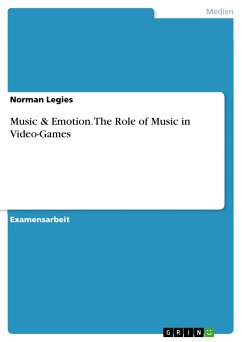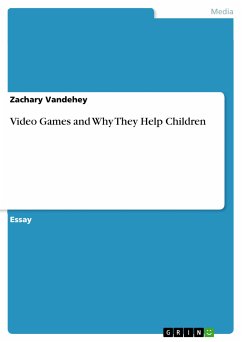Examensarbeit aus dem Jahr 2015 im Fachbereich Medien / Kommunikation - Multimedia, Internet, neue Technologien, , Sprache: Deutsch, Abstract: The purpose of this research is to combine theories of manipulative use of music with videogaming. In recent years, video-gaming has become more important, due to an ever rising popularity among children, teenagers and adults alike. The first part researches general facts about music listening in different environments, while the second and third part concentrate on video-game genres and their music, the theory of composing, as well as the social impact and phenomena arising from the increase of video-gaming in pop-culture awareness. Specific uses of video-game music are presented with recommended listening examples. With a broad approach to many aspects of music use, mood manipulation and video-game soundtracks, this paper may serve as a guidepost to further research in the field of studies of music and emotion in popular media. I was in awe: How could a scene in a game stir up so many emotions, remind of so many personal quarrels and yet comfort and soothe a young teenager, all but within a virtual world? Even when the controller was put aside, watching or remembering the scenery and story unfold, a feeling of reassurance and companionship with the protagonists came alive. Humming their melodies or quoting their wisdoms - at that time video-games were in critical observation by parents, friends and society - with an almost rebellious intent, the motivation arose to further examine and not let go of this medium. The songs were always so memorable, as they came by easily and fit a multiplicity of personal experiences. Nowadays, with video-games becoming part of main-stream media, players might still face criticism from often half-hearted examinations of video-games in news reports. Yet now, there is a community to share, speak and play with. With the increasing use of the internet, people are able to communicate with each other, duel each other with virtual cards, play mini-games, or fight strategic battles - all sharing their own proper experiences with the games' soundtracks. However, with a relatively new medium such as video-games, delving deeper into why they are becoming more and more popular is difficult. With almost a century of filmmaking dominating the entertainment industry, video-gaming created a new niche of entertainment. Collins is one of few to explore these "invaders in our homes". The use of music in video-gaming in general is even less examined. Juslin and Sloboda assembled data and essays examining the correlation of music and emotion.
Dieser Download kann aus rechtlichen Gründen nur mit Rechnungsadresse in A, B, BG, CY, CZ, D, DK, EW, E, FIN, F, GR, HR, H, IRL, I, LT, L, LR, M, NL, PL, P, R, S, SLO, SK ausgeliefert werden.









